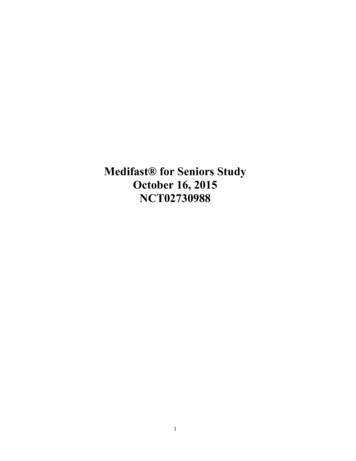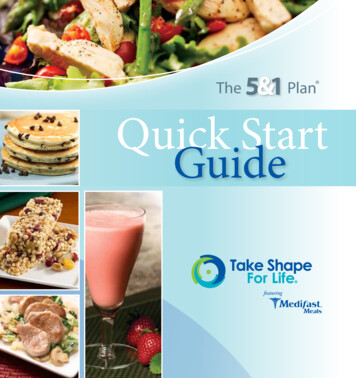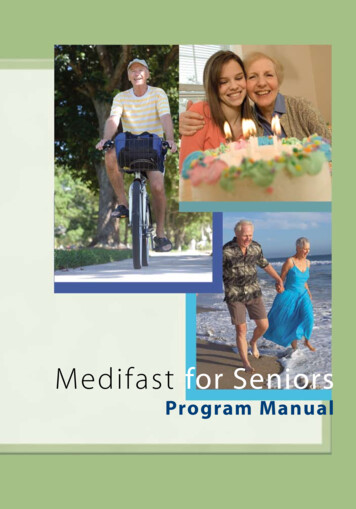
Transcription
Medifast for Seniors StudyOctober 16, 2015NCT027309881
Study Title: Medifast for Seniors StudyPrincipal Investigator: Kristen M. Beavers, PhDCo-investigator(s): Daniel P. Beavers, PhD, Rebecca Henderson, MD, and Stephen B. Kritchevsky, PhDSponsor or funding source: Jason Pharmaceuticals, Inc and the WFSM Older Americans Independence CenterBackground, Rationale and ContextAging and obesity are prevalent risk factors for morbidity and mortality. By 2030, Americans aged 65 and olderwill number an estimated 72 million people,1 half of whom will be obese.2 Both advanced age and obesity are wellcharacterized risk factors for chronic disease and disability,3 suggesting that the individual and societal health burdenof age- and obesity-related conditions will increase substantially.Intentional weight loss in obese, older adults remains controversial. Although caloric restriction, resulting insignificant weight and fat mass loss, ameliorates many clinical consequences of obesity, recommendation ofintentional weight loss in aging remains controversial.4,5 Reluctance stems, at least in part, from loss of lean and bonemass known to accompany overall weight loss,6 and potential exacerbation of age-related risk of disability7 andfracture.8,9 Accordingly, current treatment guidelines call for weight-loss therapy that minimizes muscle and bonelosses for older persons who are obese and who have functional impairments or medical complications that can benefitfrom weight loss.10Emerging results from randomized controlled trials demonstrate caloric restriction and exercise interventions,resulting in weight loss of 7-10%, are associated with initial improvement in muscle strength and function in olderadults;11-16 however, in few cases has the effect of caloric restriction, independent of exercise, been evaluated.13,16 andno randomized controlled trials have examined the role of specific dietary components, as adjuvants to weight loss, onphysical function. Evidence supporting a diet-based weight loss approach in obese, older adults with functionalimpairments has tremendous clinical significance as multiple behavior changes are often difficult to implement andmaintain, and many older adults are unable (or unwilling) to engage in the amount of physical activity typicallyprescribed in lifestyle-based interventions.Amount of dietary protein consumed during caloric restriction may be a key determinant in maintaining fatfree mass during weight loss. Adequate dietary protein is essential for skeletal muscle anabolism; and,epidemiological evidence in older adults point to a salutary effect of protein intake above the current RDA (0.8g/kg/day) on body composition.17,18 Indeed, a recent position statement by the PRO-TAGE study group advisesconsumption of 1.0-1.2 g/kg/day in older adults during weight-stable conditions to aid in the maintenance of leanbody mass and function.19 Practical achievement of this level of protein intake is often difficult for obese, older adultsundergoing weight loss, yet may be critical to offset weight loss-associated lean mass loss. Preliminary data from ourgroup show a lean mass sparing effect of high protein consumption during caloric restriction. In post-menopausalwomen undergoing a 5-month intentional weight loss program, consumption of a high (1.2 g/kg/day) versus low (0.6g/kg/day) protein diet was associated with 50% attenuation (17% vs. 37%) of lean mass loss.20 While promising,results have yet to be translated to functional changes in a tightly controlled trial of weight loss in obese, older adults.The primary goal of this study is to determine whether adherence to a high protein ( 1.0 g/kg/d) weight lossprogram results in improved physical function by favorably affecting body composition compared to weightstability in obese, older adults. This will be accomplished by conducting a 24-week trial in 124 obese (BMI 30-42kg/m2), older (65-79 years) men and women, at risk for mobility disability, randomized to either: (1) high proteinintake ( 1.0 g/kg/d; n 62) during weight loss, or (2) weight-stable control (n 62).Specific Aim 1: To compare the effects of high protein intake during weight loss versus weight stability on 24-weekchanges in physical function, primarily assessed by performance on the fast 400-meter walk test. We hypothesize thatparticipants randomized to a high protein weight loss intervention will experience greater improvements in 400-meterwalk gait speed than participants who receive the weight-stable control condition.Specific Aim 2: To compare the2
effects of high protein intake during weight loss versus weight stability on 24-week body composition changes(assessed by whole-body DXA). We hypothesize that participants randomized to a high protein weight lossintervention will present with a more favorable (i.e. higher) post-intervention lean to fat mass ratio compared toparticipants who receive the weight-stable control condition.In exploratory analyses we will also examine the effects of intentional weight loss on a compilation of physiologic andbiochemical markers (including: respiratory and kidney function, cognitive processing speed, inflammation, and bloodpressure), shown in epidemiologic investigations to predict mortality.21 Meta-analytic data from our group suggest a15% reduction in mortality for obese adults undergoing intentional weight loss,22 and better understanding of thepotential mechanism(s) underlying this association is of great clinical interest.Methods and MeasuresRecruitment of study participants: We plan to recruit up to 124 obese (BMI 30-42 kg/m2), older (age 65-79 years) menand women with mobility disability from communities in and around Forsyth County, NC via media advertisements, massmailings, and direct mailings. Based on our experience in recruitment of the designated population, we are confident inour ability to recruit older adults who meet the inclusion/exclusion criteria (see Table 1). We plan to recruit at a rate of10-12 per month.Table 1. Inclusion and exclusion criteriaInclusion CriteriaAge 65-79 yearsBMI 30-42 kg/m2Confirmation of self-reported mobility disability, as assessedby phone screen/clinical staffSelf-reported sedentary behaviorNon-impaired cognitive function (MoCA 18)Stability of residence for next 2 yearsWilling and able to follow dietary protocolWilling to provide informed consentApproved for participation by study physicianNot involved in another behavioral or interventional researchstudyAble to provide own transportation to study visits andInterventionExclusion CriteriaWeight loss or gain ( 5%) in past 6 monthsPrior bariatric surgeryMultiple food allergiesDifficulty with hearing/vision that interferes with study participationExcessive alcohol use ( 14 drinks/week)Smoker ( 1 cigarette/d within year)Insulin-dependent or uncontrolled diabetes (FBG 140 mg/dl)Uncontrolled hypertension (BP 160/100 mmHg)Abnormal kidney tests (GFR 40, creatinine 2.0)Regular use of medications that may influence body weight orcompositionSevere systemic disease (diagnosis of Parkinson’s disease, chronic liverdisease, systemic rheumatic condition, gout, thyroid disease, end stagerenal disease) or other systemic diseases/abnormal laboratory valueswhich would preclude participants from safely participating in theprotocol or impair their ability to complete the studySevere symptomatic heart disease or cardiovascular procedurewithin the past 3 months or history/current diagnosis/signs andsymptoms of heart failure, with either reduced or preserved LeftVentricular ejection fraction.Cancer requiring treatment in past year, except skin cancersNot dependent on a cane or walkerNo evidence of clinical depression, eating disorder, or othercontraindications for participation in voluntary weight lossEnglish literacyJudged unsuitable for the trial for any reason by clinic staffParticipant screening, assessments and randomizationAll participants who respond to our recruitment strategies will initially be screened via telephone to determine generaleligibility. Individuals who pass the telephone screening will be scheduled for a visit at the Sticht Center on Aging for ascreening visit. Before any data collection, all participants will be asked to provide written informed consent toparticipate in the study and complete a HIPAA authorization form in accordance with the WFSM Institutional ReviewBoard policies.Table 2 summarizes the proposed assessment timeline (see appendix for week-by-week assessment table). At thescreening visit, all inclusion and exclusion criteria will be reviewed (including participant demographics and measurementof weight and height to calculate BMI). After confirmation of meeting demographic and BMI criteria (this may be thesame day as the screening visit), participants will proceed with Baseline Visit 1 (BV1) assessments, including a fasting3
blood draw for a metabolic panel, blood cell count, and blood for storage. After a snack, participants will undergo furtherassessment for blood pressure, depression (using the Center for Epidemiologic Studies Depression Scale; CES-D),cognition (using the Montreal Cognitive Assessment; MoCA), processing speed (Digit Symbol Substitution test; DSST),spirometry (FEV1), waist circumference, and grip and leg power/strength. At the end of this visit, participants will beprovided with instruction on how to collect accelerometry data and a 24-hour urinary specimen to assess protein intake,both of which will be collected at the subsequent testing session. Because several measures that are taken at the BV1 visitalso serve as screening tests (including: blood work from the metabolic panel, blood pressure, depression, and cognition),any person with results from these tests that do not meet eligibility criteria will not be invited to enroll and as indicated,advised to share any abnormal test results with their physician. Also, any participant with abnormal test results at thefollow-up testing visits will be referred for further medical evaluation.The second baseline testing session (BV2) will occur in the Wake Forest University Department of Health andExercise Science. During this visit, participants will undergo muscle function tests (expanded Short Physical PerformanceBattery (SPPB) test, Timed-Up-and-Go (TUG) test, fast 20-meter and 400-meter walk tests, and stair climb test), DXAscan (whole body, hip and spine), physical activity questionnaire (Community Healthy Activities Model Program forSeniors; CHAMPS), quality of life questionnaire (SF-12), disability questionnaires (Pepper Assessment Tool forDisability; PAT-D and Mobility Assessment Tool-short form; MAT-sf), and instructions will be provided for a dietaryrun-in (approximately 30 minutes). For the dietary run-in, all participants will be provided with and oriented to theMedifast QuickStart Guide, sample meal plans, 3, one-day dietary trackers, a sampling of 12 Medifast MealReplacement Products, 3, one-day Product Evaluation Forms, and asked to follow the Medifast 4 &2 &1 PlanTM for athree day period occurring over the following week. Participants will be contacted by the study registered dietitian (RD)upon completion of the dietary run in period to assess their willingness and self-efficacy to adhere to the dietary protocolfor the duration of the study (24 weeks). Participants who indicate that they are willing and able to follow the protocolwill be randomized (RAND) to one of the 2 study interventions (high protein weight loss group vs. weight stable controlgroup), with blocking stratified by gender, and treated in 5 successive waves (n 12-13 participants/group/wave).Randomization of the entire wave (n 24-26) will occur approximately 1week prior to the start of intervention, and at thistime the first monthly Medifast product order will be placed for participants randomized to the high protein weight lossgroup.All assessments conducted at the BV1 and BV2 testing sessions will be repeated at two follow-up visits (FV1 andFV2), occurring during the last two weeks of active intervention (weeks 23-24). Lastly, a brief midpoint visit (MP; week12) will occur for all participants, where only DXA and fast 400-meter walk tests will be performed.Table 2. Proposed Assessment TimelineLocation of VisitWeek NumberInformed consent, review inclusion/exclusion criteria(including demographics and BMI)BV1/ Fasting blood draw, snack, blood pressure, depressionFV1screen (CES-D), cognitive function (MoCA), waistcircumference, cognitive processing speed (DSST),spirometry (FEV1), grip strength, leg muscle/power,instructions for accelerometry and 24-h urinary nitrogentestBV2/ Muscle function tests (expanded SPPB, TUG, fast 20-mFV2gait speed, fast 400-m walk test, stair climb) DXA(whole body, hip, spine), CHAMPS, SF-12, PAT-D,MAT-sf, dietary run-in instructionsRAND RandomizationMPDXA and fast 400 meter walk test (at 12-week visit, only)INTBi-weekly adherence monitoring (weight, dietarytrackers, meet with study dietitian as needed).Note: official pre/post intervention weights will becaptured at weeks 0 and 24, respectivelyVisitCodeSV1Study Interventions4Sticht-3WFU-2WFU WFU-10-24Sticht23WFU24XXXXXXXX
High Protein Weight Loss Group - Participants randomized to the high protein weight loss group will follow theMedifast 4 & 2 & 1 Plan , targeting 10% weight loss over the 24-week study. Weight loss will be monitored bi-weeklyto ensure the safety of the study participants. This level of weight loss will be achieved through a combination of mealreplacement products (MRPs), meal plans, and individual nutrition/behavioral counseling. Participants will follow theMedifast 4 & 2 & 1 Plan which includes consumption of total of 4 Medifast MRPs per day, with the addition of 2 lean andgreen meals and 1 Healthy Snack. Medifast MRPs each contain 90-110 kcals and 10-15 g protein. The lean and greenmeals will be prepared by the participants and each will consist of 5-7 oz. lean protein, 3 servings of non-starchyvegetables and up to 2 servings of healthy fat. The snack will consist of one serving of fruit, dairy, or grain. Participantswill be guided by the study RD on their food purchasing and preparation of the other meals and will be encouraged toconsume only what is approved from the menu.In addition to receiving dietary counseling, all participants randomized to the high protein weight loss group willattend behavioral counseling group classes led by the RD. These classes will be held bi-weekly for the duration of thestudy (with an additional phone call at week 1) to provide participants an opportunity to review specific questions andproblems. Group counseling sessions will provide support and introduce new topics in behavioral weight controlincluding self-monitoring, portion control, mindful eating, coping with negative thoughts related to overeating, eating atregular times, and stress management. Weight will be measured bi-weekly, at each class, to provide additional feedbackand to increase motivation. Official study baseline and post-intervention weights will occur at weeks 0 and 24 ofintervention, respectively. Additionally, participants will complete daily food logs which will be reviewed by the RD toverify compliance to the diet. If it is evident, either through inadequate body weight loss or diet records, that participantsare not compliant with the diet, additional individual counseling sessions with the RD will be held to improve compliance.Also, at week 24, participants in this group will be asked to complete a program evaluation form to solicit feedback onoverall weight loss program product satisfaction and desired future usage, as well as product quality and taste feedbackand recommendations.Weight Stable Control Group – Participants randomized to the weight stable control group will be monitored bi-weeklyby study staff (with an additional phone call at week 1) to ensure weight stability over the course of the study. Participantswill be weighed on a bi-weekly basis and encouraged to maintain weight within 5% of baseline. To promote complianceand retention, participants will also be invited to bi-weekly group educational sessions, where non-weight loss healthrelated topics (including: What is Successful Aging?, Preventing and Delaying Disease and Dysfunction, ManagingMedications Effectively, and Talking Effectively with Your Healthcare Provider), will be discussed by study staff.Lastly, if weight stable participants are able to attend 75% (i.e. 9 of 12) educational sessions, all baseline and follow-uptesting sessions, and maintain weight stability over the course of the study (defined as less than a 5% differential betweenweight measured at week 0 and 24), they will be eligible to receive up to 3 months of Medifast MRPs along with a 30-60minute RD-led dietary instruction session on how to follow the Medifast 4 & 2 & 1 Plan.Methods for Study AssessmentsThe nature, purpose, and risks of all procedures and protocols will be explained to each participant prior to obtainingwritten consent. All examiners are trained in the standardized conduct of all assessments before data collection.Participants will be instructed to wear appropriate and comfortable clothing, and standardized written instructions will beprovided prior to each study visit.Study Measure(s)1. Height, body mass, BMI, & waist circumference. Height without shoes will be measured to the nearest 0.1centimeter using a stadiometer and body mass will be measured to the nearest 0.1 kilogram using a calibratedand certified balance beam scale. Height and body mass will be used to calculate BMI. Waist circumferencewill be measured to the nearest 0.1 cm with a Gulick-II spring-retractable steel tape.2. Muscle function and strength measures include the tests described below. Each will be conducted before andafter the interventions, with the exception of the 400-meter walk test, which will also be performed at thestudy midpoint (12-weeks). Gait speed will be assessed using the fast 20-meter and 400-meter walk tests. The400-meter walk tests was originally developed in Health ABC23 and used by our group in the CLIP and LIFEstudies.12,24 Participants are asked to walk 10 laps of a 40-meter course (20 meters out and 20 meters back). Ascript is used to standardize instructions to all participants. It says: “You will be walking 10 complete lapsaround the course, about ¼ mile. Please walk as quickly as you can, without running, at a pace you can5
maintain over the 10 laps. After you complete the 10 laps, I will tell you to stop.” On each lap the assessoroffers standard encouragements (“Keep up the good work”, “Good job”) and indicates the number of lapscompleted and the number remaining. Participants can stop and rest if necessary, but are not allowed to sit, andare given a maximum of 15 minutes to complete the test. The reliability and validity of the 400-meter walk testare excellent,25,26 and performance is an important prognostic indicator for total mortality, cardiovasculardisease, and mobility disability in older adults.27 Physical performance will be assessed using the expandedShort Physical Performance Battery (SPPB). The expanded SPPB consists of 5 repeated chair stands, standingbalance (semi- and full-tandem stands and a single leg stand for 30 seconds), a 4-meter walk to assess usualgait speed, and a narrow 4-meter walk test of balance (walking at usual pace within lines of tape spaced 20 cmapart).28 Scores for the traditional 0-12 point SPPB can also be obtained from these tests. We will also assessphysical performance using the Timed-Up-and-Go (TUG). TUG measures the time a person takes to stand upfrom a standard chair, walk 3 meters, turn, walk back to the chair, and sit down again.29 A practice trial isgiven, followed by two timed trials and the results of the timed trials are averaged. Stair climbing time willbe assessed by measuring the fastest time achieved to climb 4 steps on a 4-step staircase (test will beperformed 2 times). Lower extremity muscle power will be measured using the Nottingham Power Rig, asafe, convenient method for assessing power output from the lower limb which has been used reliably in olderadults.30 Participants will sit in a chair and unilaterally depress a foot lever attached to a flywheel as hard andas fast as they can. Power output, derived from the acceleration of the flywheel, will be recorded in Watts.Power will be averaged for each leg following 5 trials at maximal effort. Participants that have had a unilateralhip or knee replacement should not have that side tested. Participants who have had eye surgery (e.g., cataractsurgery) within the past month should not be tested. Lower extremity muscle strength will be measuredusing an isokinetic dynamometer (Biodex/KinCom) at one speed (60 /sec) with the participant sitting and thehips and knee flexed at 90 . The dynamometer will be adjusted for each participant and all adjustments will berecorded to duplicate the position for subsequent assessments. Start and stop angles will be set at 90 and 30 .Participants will be asked to extend the knee and push as hard as possible against the resistance pad. Strengthis expressed as peak torque in Newton-meters (Nm). The best performance of 3 trials will be selected for eachside, and the averages of the left and right leg will be used in analyses. Grip strength will be measured twicein each hand to the nearest 2 kg using an isometric Hydraulic Hand Dynamometer (Jamar, Bolingbrook, IL)and the mean value from the stronger hand used. Participants will be excluded from performing the test if theyreport hand-pain or recent hand or wrist surgery.3. Body composition. Dual Energy X-ray Absorptiometry (iDXA, GE Medical Systems, Madison, WI;located in the Health and Exercise Science Department, WFU). Whole body scans will be acquired with theparticipant supine and aligned with the scanner table as prescribed by the manufacturer. DXA will also beused to analyze bone mineral density (BMD) using specific scans of the anterior-posterior (AP) spine (L1-L4)and proximal femur. Coefficients of variation (CV) from repeated measurements are 1.0% for lumbar spineBMD and 1.0% for femur BMD. All scans will be performed and analyzed by our trained DXA technicianwho is certified by the International Society for Clinical Densitometry and has vast experience in bodycomposition measurements in older adults. Every scan will be examined to evaluate for proper patientpositioning and analysis, and reanalysis or rescanning will be performed if necessary. Any artifacts will benoted and, if possible, excluded from the measured region. Daily quality control scans are obtained with GE’sphantoms. If results are more than 2 SD from baseline we repeat the phantom scan. If the results of bothscans are more than 2 SDs from baseline we do not measure any more individuals and have the scannerserviced. Each week, the daily phantom data are analyzed to detect drifts. If changes in software or themachine occur, the scanner will be calibrated with the new software to ensure consistency.4. Accelerometry will be used to objectively assess physical activity over a 7 day period at baseline and atfollow-up. The ActiGraph wGT3X-BT is a compact, hip mounted electronic pedometer, using a 3-axisaccelerometer and digital filtering algorithms to measure the amount and frequency of movement over 24hours for up to 40 days. It provides physical activity measurements including raw acceleration, activity countsand vector magnitude, energy expenditure, steps taken, physical activity intensity, and body position.5. Cognitive function. This will be assessed during screening using the Montreal Cognitive Assessment(MoCA), participants must score 18 to be eligible. We will also assess psychomotor speed, attention, and6
working memory using the Digit Symbol Substitution Test (DSST).31 Participants are given a series ofnumbered symbols and then asked to draw the appropriate symbols below a list of random numbers. Thescore is the number of correctly made matches in 2 minutes (120 seconds). The cognitive function tests willbe audio recorded by the assessor using a hand held digital recorder. The recordings will be used to properlyscore the tests as well as be available for quality control testing. The recordings will be deleted once the studyis over and the data that was entered has been verified.6. Biomarkers of longevity. To generate preliminary data for future grant proposals, we will collect informationon a compilation of physiologic and biochemical markers shown in epidemiologic investigations to predictmortality. Ventilatory capacity will be assessed by spirometry recorded by the EasyOne PLUS spirometerto record average FEV1 over three reproducible trials. Kidney function will be assessed by obtaining a basicmetabolic panel (BMP) at baseline and follow up. Blood pressure and pulse will be measured in the rightarm, using an automatic Omron device, with the participant in a seated position after having rested quietly for5 minutes. They will sit with feet flat on the floor and legs uncrossed and will be asked not to talk during therest period or during the measurement. Appropriate cuff size will be used. Systolic and diastolic bloodpressure will be defined as the average of two repeated measures. Interleukin-6 will be assessed in plasmasamples that will be measured in blood drawn after an overnight fast at baseline and follow up. All assays willbe conducted in the Cytokine Core laboratory directed by Dr. Barbara Nicklas (WFSM). We will also takeadvantage of the study design to collect and store serum and plasma for later assessment of biomarkers toidentify potential mechanisms underlying the effects of the intervention on muscle and bone loss duringweight loss.7. Self-reported variables: Demographic characteristics including age, gender, race, education level, and socioeconomic status will be recorded and used as covariates if necessary. Physical activity will be measured usingthe CHAMPS Physical Activity Questionnaire for Older Adults at baseline and follow-up.32 Activities ofdaily living will be assessed using the Pepper Assessment Tool for Disability (PAT-D) at baseline andfollow-up. This questionnaire covers 3 domains: (1) basic activities of daily living (ADLs) (moving in and outof a chair, moving in an out of a bed, gripping with hands, using toilet, dressing, getting in and out of a car,and bathing); (2) mobility (walking several blocks, lifting heavy objects, walking 1 block, lifting/carrying 10lbs, climbing several flights of stairs, and climbing 1 flight of stairs); and (3) instrumental ADLs (lighthousework, participating in community activities, managing money, visiting with relatives or friends, usingthe telephone, and taking care of a family member). For each item, respondents answer whether theyexperience 1) no difficulty, 2) a little difficulty, 3) some difficulty, 4) a lot of difficulty, 5) unable to do or, 6)did not do for other reasons. Answers are averaged across the items, in order to better assess the overallperceived disability burden by a person. Additionally, activities of daily living will be assessed using theMobility Assessment Tool – Short Form (MAT-sf) at baseline and follow-up. This is a novel, computerizedtool for self-assessment of functional performance designed to reduce bias from factors such as age, genderand body image. The Short Form 12 (SF-12) will be used as a generic measure of health related quality oflife.33 The questionnaire consists of two norm-based composite T-scales, assessing mental health and physicalfunction. Lastly, mood will be assessed using the 10-item Center for Epidemiologic Studies DepressionScale (CES-D).8. Compliance and satisfaction: Although we will attempt to control compliance by the use of behavioralstrategies, there may be inter-individual variability in compliance to the weight loss protocol. Therefore,participant weight will be collected at regular, bi-weekly intervals for both groups. Additionally, participantsrandomized to the high protein weight loss group also will be asked to provide information on daily dietaryintake and complete a satisfaction survey at the end of intervention to express thoughts and feelings aboutfollowing the Medifast 4 & 2 & 1 Plan. Lastly, 24-hour urine nitrogen will be assessed to ensure differentialprotein intake by sending participants home with a container and instructions at baseline and follow up.Participants will be asked to: (1) void at 8 AM and discard the specimen; (2) collect all urine including the finalspecimen voided at the end of the 24-hour collection period (i.e., 8 AM the next morning); (3) screw the lid onsecurely. The sample can be stored at room temperature or refrigerated for up to 14 days and when the sample isreturned, it will be sent to Labcorp for analysis.7
Statistical AnalysesSample size: Unpublished data collected in older participants undergoing a 6-month weight loss intervention indicate thatwe can anticipate a clinically meaningful 400-meter walk gait speed difference of at least 0.05 m/s, with a common groupstandard deviation of 0.19 m/s and a correlation of 0.85 between baseline and 6-month measures. Using the method ofBorm et al (2007),34 we assume using an analysis of covariance (ANCOVA) analytic approach fitting the randomizationeffect and baseline gait speed, then 53 subjects completing the intervention per group will yield 80% power using a twosided alternative hypothesis at the 0.05 level of significance. Assuming a conservative drop-out rate of 15%, we plan toenroll 124 participants (n 62/group).Database management: To facilitate data transfer and preserve records that can be audited, we will use hard copy formscollection. All data will be manually entered within one week of collection into the study database. Our data entry systemwill protect confidentiality and data security and the use of text containing identifying information will be avoided. D
Medifast QuickStart Guide, sample meal plans, 3, one-day dietary trackers, a sampling of 12 Medifast Meal Replacement Products, 3, one-day Product Evaluation Forms, and asked to follow the Medifast 4 &2 &1 PlanTM for a three day period occurring over the following week. Participants will be contacted by the study registered dietitian (RD)










